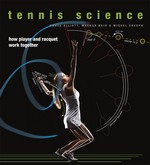Men's Versus Women's Serving:
What is the Role of Internal Rotation?
Bruce Elliott and Machar Reid
If we compare the highest service speeds of top players in men's and women's professional tennis, the speed of the female serve is on average approximately 80% that of the male serve.
Milos Raonic, for example, has been recorded at 155 mph and Serena Williams at 129 mph. Sam Groth has hit the fastest the fastest serve on record on the ATP tour at 163mph. Venus Williams has the fastest recorded WTA serve at 130 mph.
Are these differences due purely to strength and physical size, or does technique also play a role?
There are obvious physical differences between men and women, but one movement clearly differentiates male from female players where service speed is concerned. This is shoulder internal rotation. (Click Here for additional explanation of this critical movement.)
Research shows that internal shoulder rotation is the largest contributor (approximately 40%) to the generation of racket velocity at impact in the male high performance serve.
There is also comparative data suggesting the speed of this rotation accounts for the differences in the serves between men and women.
If you compare the internal rotation velocity of male professional players analyzed at the Sydney Olympics' with that of an analysis of Australian female professionals, the speed of the rotation for females is almost 20 percent less.
The actual number is 83% of the males' values. Interestingly this difference is about the same as the differences in ball speed.
While it is too simplistic to say that this is the sole cause of the serve velocity differential, it is a revealing comparison that should be a consideration for female players wanting to increase their service velocity.
(For an article by John Yandell that experimented with increased internal shoulder rotation in a high level female ITF player and the effect this had on ball velocity, Click Here.)
So what is internal shoulder rotation exactly? It must first be set up by the rotation of the arm in the shoulder joint in the opposite direction.
The arm must externally rotate (ER) during the backswing to put the muscles of the shoulder (the internal rotators) on stretch. This then positions the racket for acceleration to impact.
Internal rotation (IR) occurs during the forward swing to impact. Internal rotation then continues into the followthrough. This is the motion that most assists the generation of racket speed at impact.



Coaches and young players alike must be careful to choose when they emphasize the importance of internal rotation in the service action. For example, research has observed that increases in internal rotation velocity occur primarily after puberty.
Therefore, it is possible that young players should attend to other aspects of the service action and lay the foundations for appropriate internal rotation velocity development prior to puberty, so that they can most effectively use this aspect of the serve when they mature.






